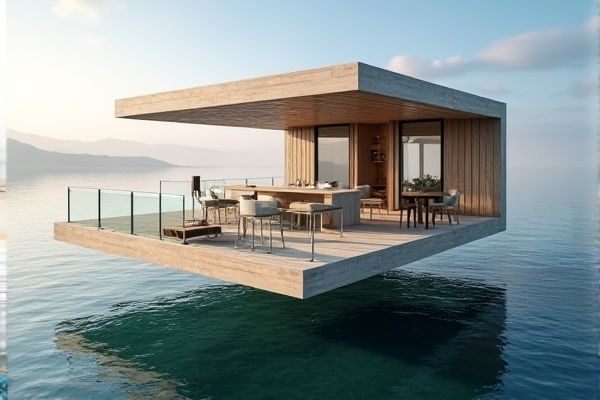
Floating islands are stationary structures typically anchored in one location, offering stability and a fixed ecosystem, while mobile islands are designed to move across water, providing flexibility and adaptability for various uses. Discover how these innovative landforms differ and which one might best suit Your aquatic needs by reading the full article.
Table of Comparison
| Feature | Floating Island | Mobile Island |
|---|---|---|
| Definition | A stationary, buoyant structure on water | A movable, buoyant platform designed for water navigation |
| Mobility | Fixed location, no self-movement | Capable of relocation and navigation |
| Use Cases | Residential, recreational, ecological habitats | Transport, leisure cruises, mobile workspaces |
| Structure | Buoyant base, often modular, anchored | Buoyant platform with propulsion systems |
| Examples | Hydropolis, floating farms, flood-resistant homes | Houseboats, floating yachts, mobile office platforms |
| Environmental Impact | Minimal movement reduces disruption | Movement may affect aquatic ecosystems |
| Cost | Lower operational costs due to fixed position | Higher costs due to mobility and propulsion |
Floating Island vs Mobile Island: Key Differences
Floating islands are naturally occurring or artificial land masses that remain stationary on water surfaces, often created by vegetation mats or engineered platforms; mobile islands, however, are designed to move or be relocated, employing technologies such as pontoons or modular sections for flexibility and transportation. Floating islands typically support ecosystems, biodiversity, and water filtration, while mobile islands emphasize adaptability, temporary use, and dynamic positioning in marine environments. The primary difference lies in their purpose and mobility--stationary ecological habitats versus movable structures suited for various maritime or recreational applications.
Structural Design and Engineering
Floating islands utilize buoyant platforms made from materials like foam or hollow plastic to achieve stability and support vegetation, relying on anchored pontoons or flexible moorings to adapt to water movement. Mobile islands incorporate advanced structural engineering with reinforced hulls and dynamic ballast systems that allow controlled navigation and repositioning on water bodies. Your choice depends on whether you need a stationary, eco-friendly habitat or a transportable living space engineered for mobility and resilience.
Mobility and Navigation Capabilities
Floating islands remain stationary and primarily rely on natural water currents and winds for minimal movement, limiting their mobility and navigation control. Mobile islands are engineered with propulsion systems such as thrusters or engines, granting you precise navigation and the ability to relocate actively across water bodies. Enhanced mobility of mobile islands enables strategic positioning and adaptability, which floating islands lack due to their passive drifting nature.
Energy Sources and Sustainability
Floating islands primarily utilize renewable energy sources such as solar panels and wind turbines, harnessing natural elements to ensure sustainable operation while minimizing environmental impact. Mobile islands often rely on hybrid energy systems combining traditional fuels and renewable sources, which can affect their overall sustainability due to fuel dependency and emissions. You can prioritize energy efficiency and sustainability by choosing floating islands designed to maximize clean energy integration and reduce carbon footprints.
Environmental Impact Comparison
Floating islands typically have a lower environmental impact due to their integration with existing aquatic ecosystems, promoting biodiversity and natural water filtration. Mobile islands often require more energy for movement and can disturb marine habitats through propulsion systems and anchoring, leading to potential ecological disruption. Understanding these differences helps you make informed decisions about sustainable living or development on water bodies.
Residential and Commercial Uses
Floating islands primarily serve commercial purposes such as eco-tourism resorts, research centers, and aquaculture farms, leveraging their customizable natural environment and water-based locations. Mobile islands offer flexible residential solutions including temporary or seasonal housing, emergency shelters, and luxury floating homes, with the ability to relocate based on environmental or personal needs. Both floating and mobile islands integrate sustainable technologies like solar power and water recycling to support off-grid living and commercial activities on water.
Safety and Stability Considerations
Floating islands provide enhanced stability as they are anchored to the seabed or lakebed, reducing the risk of drifting and offering safer platforms during adverse weather conditions. Mobile islands, designed for movement, prioritize flexibility but require advanced stabilization technology such as dynamic positioning systems or passive stabilizers to maintain safety in rough waters. Safety protocols on both involve rigorous structural integrity testing and real-time monitoring to prevent accidents and ensure occupant security.
Legal and Regulatory Issues
Floating islands face complex legal challenges related to sovereignty, maritime boundaries, and environmental regulations, as they are often considered part of a nation's territorial waters or international waters depending on their location. Mobile islands, being movable, pose unique difficulties in jurisdiction determination, often requiring new legal frameworks to address property rights, navigation laws, and international maritime agreements. Both types of islands must navigate overlapping regulations from environmental protection statutes, maritime law, and national security policies to ensure compliance and avoid disputes.
Economic Feasibility and Costs
Floating islands generally have lower initial construction costs due to simpler materials like pontoons and modular platforms, making them economically feasible for small-scale applications. Mobile islands, designed with complex propulsion systems and structural reinforcements for movement, incur significantly higher expenses in both construction and ongoing maintenance. Operational costs of mobile islands include fuel, navigation, and repairs, often outweighing the static economic advantages of floating islands anchored in stable locations.
Future Prospects and Innovations
Floating islands leverage advanced materials and renewable energy technologies to enhance sustainability and resilience against climate change, positioning them as viable solutions for coastal urban expansion and ecological restoration. Mobile islands, equipped with autonomous navigation systems and adaptive infrastructure, offer unprecedented flexibility for disaster response, tourism, and offshore resource exploration, reflecting significant innovation in marine mobility. Future prospects emphasize integration of smart sensors and AI to optimize environmental impact, energy efficiency, and human habitation, driving transformative growth in both floating and mobile island ecosystems.
 homyna.com
homyna.com